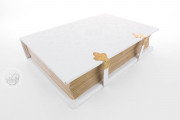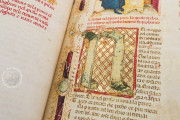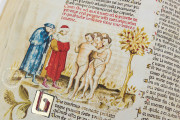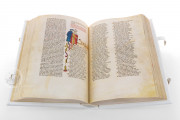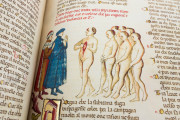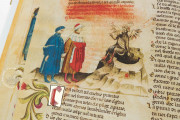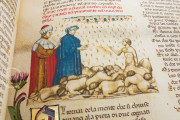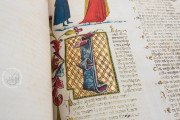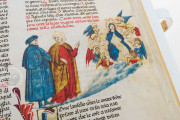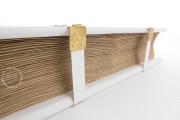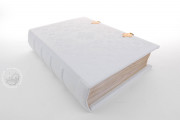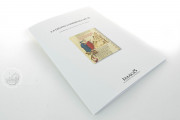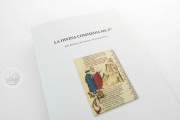The manuscript Codice 67 in the Seminario Vescovile in Padua is an exquisite version of Dante's Divine Comedy from the Italian peninsula. The codex was written and illuminated toward the end of the fourteenth century and features 100 beautifully illustrated miniatures, one per each canto. With its balanced use of gold and vivid colors, this manuscript is justly considered an outstanding work of Italian production.
Codice 67 and Its Commentaries: Jacopo della Lana and Andrea della Lancia
Written in Italian, this manuscript contains the literary foundation of Italian literature: Dante's Divine Comedy. It also features the commentary of Jacopo della Lana for each canto with the exception of canto I along with the proemium, both of which are accompanied by a commentary of Andrea della Lancia, known as "L'Ottimo."
Michelino da Besozzo: Late Gothic Iconography
The iconographic apparatus is extensive, consistent, and well-thought-out. Illuminated by a single artist, it provides descriptive images that summarize the events taking place throughout the canto. Also worthy of notice are the decorative elements such as initials featuring fruits and flowers echoing a post-Giotto artistic culture, but open to the modern and sophisticated late Gothic sensibility.
The outline of each leaf is neat and consistent with the miniatures functioning as a break from the structure (fol. 277r), invading the empty borders with their vivid gold, red, and blue colors.
The iconography of the manuscript seems to be the work of Michelino da Besozzo, active in the first part of the fifteenth century in the Veneto region (Verona, Vicenza, and Venice), and one of the most talented late Gothic artists in Lombardia.
Obscure Life of the Manuscript
The manuscript seems to have found its way to the Biblioteca del Seminario in 1720, at the death of Alfonso Alvarotti, who along with Codice 67 bequeathed his entire collection to the library, including the Padua 9 Manuscript.
Although the commissioner remains unknown, the coat of arms on the first leaf of the Inferno – although very worn out – could be attributed the Obizzi family who had ties both in the Ferrara and Padua area.
It seems certain that in the mid-fifteenth century, specifically in the years preceding 1456, the manuscript was kept temporarily in Ferrara so as to create a copy of it commissioned by Gaspare di Tommaso di Montone for a magistrate in Ferrara. The copy, indeed, resembles very closely both the illustrative and decorative elements of Codice 67.
Beautiful Example of Gothic Rotunda
Codice 67 exhibits a beautiful example of Gothic rotunda – written with a neat and precise hand – with the use of two shapes of d, r, and s and with no abbreviations.
We have 1 facsimile edition of the manuscript "Divine Comedy - Padua 67 Manuscript": Divina Commedia degli Obizzi facsimile edition, published by Imago, 2017
Request Info / Price

